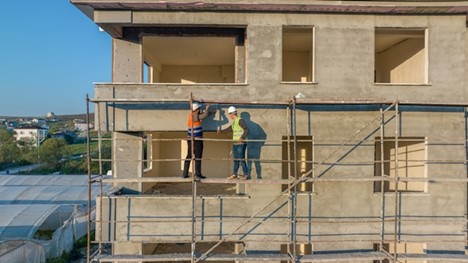Caleb Walsh is the managing director at Urban Bay Financial, a commercial real estate financing company. In the following article, he explores everything developers and builders need to know about construction loans, from understanding the basics to navigating the application process and managing the loan effectively.
Embarking on a construction project, regardless of whether it’s a new home, a commercial property, or a residential development, is a significant endeavor that demands meticulous planning and financing. Caleb Walsh of Urban Bay Financial says that from the initial conception of the project to its completion, every stage requires careful consideration and execution to ensure success. At the heart of financing construction projects lies the critical element of securing a construction loan, which serves as the financial backbone for turning vision into reality.
A construction loan is a specialized type of financing designed explicitly for construction projects. Unlike traditional mortgage loans that provide funds upfront for the purchase of a completed property, a construction loan disburses funds gradually as the project progresses through its various stages of development. This phased disbursement approach aligns with the incremental nature of construction work, ensuring that funds are allocated efficiently and used for their intended purpose.
Whether you’re building a custom home, renovating an existing property, or undertaking a large-scale commercial development, securing a construction loan is often a necessary step in the financing process. These loans provide developers and builders with the capital needed to cover construction costs, purchase materials, hire contractors, and manage other expenses associated with the project.
Caleb Walsh Breaks Down the Process

Unlike traditional mortgages, which provide funds upfront to purchase a completed property, construction loans disburse funds in stages as the project progresses. This phased approach helps mitigate the lender’s risk by ensuring that funds are used for their intended purpose and that the project meets quality standards and timelines.
Types of Loans
There are several types of construction loans available to developers and builders, each tailored to different project requirements and financing needs:
- Construction-to-Permanent Loans: Also known as “one-time close” or “all-in-one” loans, construction-to-permanent loans combine financing for both the construction phase and the permanent mortgage into a single loan. This streamlines the financing process and eliminates the need to refinance once the construction is complete.
- Construction-Only Loans: Construction-only loans provide financing exclusively for the construction phase of the project. Once construction is complete, developers must secure permanent financing, such as a traditional mortgage, to repay the construction loan.
- Renovation Loans: Renovation loans are designed for projects involving the renovation or rehabilitation of an existing property. These loans can finance both the acquisition and renovation costs, making them ideal for developers looking to revitalize older properties.
How Construction Loans Work
Caleb Walsh of Urban Bay Financial explains that these loans typically follow a disbursement schedule based on project milestones, such as completing site preparation, pouring the foundation, framing, and finishing work. Funds are disbursed to the borrower or directly to contractors as construction progresses, with the lender conducting inspections to verify completion and quality before releasing funds for the next phase.
During the construction phase, borrowers usually make interest-only payments based on the amount drawn from the loan. Once construction is complete, the loan converts to a permanent mortgage, and borrowers begin making principal and interest payments based on the loan’s terms.

Qualifying for a Construction Loan
Qualifying for a construction loan is more complex than obtaining a traditional mortgage due to the higher risk associated with construction projects. Lenders evaluate several factors when assessing a borrower’s eligibility for a construction loan, including:
- Creditworthiness: Lenders review the borrower’s credit history, credit score, and debt-to-income ratio to assess their ability to repay the loan.
- Project Feasibility: Lenders evaluate the feasibility of the construction project, including the property’s location, market demand, construction plans, and estimated costs.
- Builder Experience: Lenders may require developers to work with experienced builders or contractors with a proven track record of completing similar projects successfully.
- Down Payment: Borrowers typically need to provide a significant down payment, often ranging from 20% to 30% of the project’s total cost, to secure a construction loan.
- Financial Documentation: Borrowers must provide detailed financial documentation, including construction plans, cost estimates, income statements, and asset verification, to support their loan application.
Tips for Securing a Construction Loan
Navigating the construction loan application process requires careful planning and preparation. Caleb Walsh of Florida provides below a few tips to help developers and builders secure financing for their projects:
Develop a Detailed Project Plan
Prepare a comprehensive project plan that outlines the scope, timeline, and budget for the construction project. Include detailed construction plans, cost estimates, and a contingency fund to account for unexpected expenses.
Work with Experienced Professionals
Collaborate with experienced architects, engineers, and builders who can provide expertise and guidance throughout the construction process. Lenders may require borrowers to work with licensed professionals to ensure the project meets quality standards.
Maintain Strong Financial Health
Strengthen your financial position by improving your credit score, reducing debt, and increasing savings. A strong financial profile demonstrates to lenders that you are a responsible borrower capable of managing a construction loan.
Shop Around for Lenders
Research and compare multiple lenders to find the best construction loan terms and rates for your project. Consider factors such as interest rates, loan terms, fees, and customer service when selecting a lender.
Prepare a Comprehensive Loan Application
Present a well-prepared loan application that includes detailed project plans, financial documentation, and evidence of borrower qualifications. Be transparent and proactive in addressing any questions or concerns raised by the lender.
Managing a Construction Loan
Caleb Walsh of Urban Bay Financial explains that once you’ve secured a construction loan, effective management is essential for ensuring the project stays on track and within budget. Here are some tips for managing a construction loan effectively:
- Monitor Progress Closely: Keep a close eye on construction progress and expenses to ensure the project stays on schedule and within budget. Conduct regular site visits and meetings with contractors to address any issues or delays promptly.
- Communicate with Lender: Maintain open communication with your lender throughout the construction process. Provide updates on project milestones, budget changes, and any unforeseen challenges that may arise.
- Manage Cash Flow Wisely: Manage cash flow carefully to ensure you have sufficient funds to cover construction expenses at each stage of the project. Avoid overruns by tracking expenses closely and making adjustments as needed.
- Adapt to Changes: Be prepared to adapt to changes and unforeseen challenges that may arise during construction. Have contingency plans in place to address unexpected delays, cost overruns, or design modifications.
- Prepare for Conversion: As construction nears completion, begin preparing for the conversion of the construction loan to a permanent mortgage. Gather any additional documentation required by the lender and coordinate with all parties involved to facilitate a smooth transition.
Conclusion
Caleb Walsh of Florida says that construction loans play a crucial role in financing construction projects, providing developers and builders with the capital they need to bring their visions to life. By understanding how construction loans work, qualifying for financing, securing the right loan for your project, and managing the loan effectively, you can navigate the construction process with confidence and achieve success. Remember to consult with experienced professionals, such as lenders, architects, engineers, and contractors, to ensure your construction project is executed smoothly and efficiently. With careful planning and execution, you can turn your construction dreams into reality and create lasting value in the built environment.









